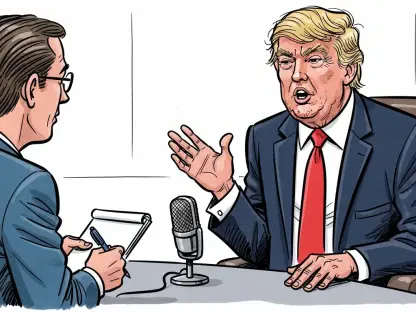Significant shifts in federal spending priorities are on the horizon with President Trump’s proposed budget for fiscal year 2026. This ambitious fiscal blueprint, presented by Russell Vought, Director of the White House Office of Management and Budget, reveals an emphasis on reducing non-defense discretionary spending while bolstering defense and border security allocations. The proposal includes deep cuts to several federal agencies, advocating fiscal measures aimed at reducing federal bureaucracy while investing heavily in national defense and immigration control. As the budget initiative progresses toward congressional deliberation, it showcases a shift in fiscal policy aimed at transforming administrative priorities and addressing national security concerns.
Strategic Shifts in Federal Spending
Non-Defense Discretionary Spending Reductions
The proposed budget introduces a substantial 22.6 percent reduction in non-defense discretionary spending. This decision aims to save approximately $163 billion, affecting numerous federal agencies and programs. Among those impacted, the National Institutes of Health (NIH) will face a reduction of about $18 billion from previous spending levels. The Department of Energy’s budget is also slated for a significant $15 billion reduction, effectively canceling projects initiated under the Infrastructure Investment and Jobs Act. These cuts demonstrate a focus on streamlining federal expenditures and prioritizing funds according to the administration’s new fiscal goals.
The Trump administration’s strategy extends to the Department of Housing and Urban Development (HUD), which stands to encounter a $27 billion cut. This reallocation transforms rental assistance programs into state-based formula grants, allowing states to develop customized systems suited to their local needs. This shift marks a move toward decentralization, giving states more autonomy in shaping rental support structures. Director Vought emphasized that crucial areas like homeland security, veterans’ affairs, and law enforcement remain protected from these budgetary reductions. The focus on reducing federal bureaucracy is portrayed as a step toward dismantling institutional inertia that has accrued over the years.
Emphasis on Defense and Border Security
In stark contrast to non-defense spending cuts, the budget signals a robust boost for the Department of Homeland Security (DHS). This includes a proposed $175 billion allocation aligned with President Trump’s immigration and border security initiatives. With a nearly 65 percent increase, the budget offers provisions for hiring additional Immigration and Customs Enforcement (ICE) agents and continuing construction of the border wall. These funds are intended to reinforce immigration control efforts prominently featured in the administration’s agenda, emphasizing both security and economic dimensions of immigration management. A notable focus is also placed on the Coast Guard, working toward addressing immigration issues effectively.
The defense sector witnesses a marked 13 percent funding increase, bringing total military expenditures to exceed $1 trillion. Congressional Republicans are crafting legislation designed to elevate defense funding by an additional $300 billion, ensuring alignment with Trump’s strategic national defense goals. Senate Armed Services Chair Roger Wicker expressed reservations regarding defense expenditures, suggesting that persisting funding levels essentially represent lower military spending when accounting for inflation. Moreover, Wicker remarked that proposed legislation is aiming to revamp Pentagon programs and fortify border security alongside advancing unmanned capabilities.
Diverse Reactions and Political Dynamics
Criticism and Support
The unveiled budget has provoked varied reactions across the political spectrum. Senator Roger Wicker critiqued the defense funding levels as perpetuating the prior administration’s allocations, expressing concern for unaltered fiscal dynamics in light of inflationary pressures. Wicker proposed that potential legislation involving Pentagon programs and unmanned capabilities could thoroughly redirect military expenditure preferences. In response, Director Vought defended the budget, stating the 13 percent defense spending increase is robust and attends to critical Department of Defense needs. He also assured stakeholders of the ongoing transformation of bureaucratic functions to fit strategic objectives.
This latest budget represents Trump’s inaugural fiscal framework in his second term, poised barely beyond the 100-day mark. Notably designated as a ‘skinny budget,’ it lacks the comprehensive detail customary in presidential budget requests; however, congressional Republicans anticipate further details illuminating spending priorities. While criticisms arose from conservative budget proponents initially, the plan reflects a coherent presentation of fiscal goals, signaling significant upcoming budget-related legislative pursuits.
Influences and Legislative Convergence
Presidential budget submissions often serve as aspirational guides, outlining executive policy inclinations for congressional appropriators who ultimately determine the federal budget through legislative mechanisms. This proposal reveals underlying administrative priorities at a juncture when Trump’s influence remains significant within the Republican Party. Senate Dynamics and key Republican actors knowledgeable about fiscal policy urged the administration to divulge spending targets, thereby informing substantial budget hearings for the coming fiscal year. Vought affirmed President Trump’s engagement in budget formulation and conveyed an aim to encapsulate Trump’s broader policy architectures in anticipated House legislative packages.
This fiscal blueprint mirrors Trump’s long-standing ambition to alter the Department of Education’s operations while invoking federalism principles in framing housing grant structures. On the international front, foreign aid reductions continue a previous trend, previously scaled back under Elon Musk’s DOGE program. A ripple effect encompasses the Centers for Disease Control and Prevention (CDC), alongside the termination of federal initiatives like Job Corps, Preschool Development Grants, and the Sexual Risk Avoidance Program, among others. However, Vought assured that indispensable programs like Pell Grants and Head Start, pivotal for early education especially among low-income families, remain unaffected.
Budget Challenges and Future Outlook
Negotiations and Legislative Impasse
Director Vought mentioned witnessing a markedly different reaction from Capitol Hill Republicans toward this budget. He suggested a collaborative approach undertaken in alignment with DOGE’s strategic aims. The Republican-controlled House of Representatives, led by Speaker Mike Johnson, declared an unequivocal commitment to working with Trump in translating this budget from proposal into tangible practice. Johnson articulated a vision for Trump’s plans to optimize taxpayer resources and align with principles of America-first policy. Within these discussions, the proposed congressional legislative piece—that alludes to ‘One Big, Beautiful Bill’—is depicted as pivotal for ensuring border security and advancing defense systems.
Concerns over fiscal responsibility, however, remain pronounced. Maya MacGuineas, who heads the Committee for a Responsible Federal Budget, acknowledged spending reduction efforts. However, she cited the budget’s permeation across a single fiscal year as a concentrated endeavor. She prompted the administration to unveil more exhaustive budget details defining an overarching fiscal objective. MacGuineas highlighted the necessity of a multi-year budget framework to restrain federal expenditures, manage borrowings prudently, and control deficit impacts on GDP, ultimately securing national debt sustainability.
Moving Forward: Analyzing Fiscal Trends
Major changes in the allocation of federal funds are anticipated with the introduction of President Trump’s proposed budget for the 2026 fiscal year. This assertive plan, unveiled by Russell Vought, head of the White House Office of Management and Budget, focuses on cutting non-defense discretionary expenses while boosting funds for defense and border security. The budget plan suggests substantial reductions in funding for various federal agencies, advocating for fiscal policies aimed at minimizing federal bureaucracy and directing significant investments into national defense and immigration control. As the proposal advances toward congressional review, it represents a strategic shift in fiscal policy intended to alter governmental priorities and address national security issues. This budget proposal not only affects government spending but also reflects broader concerns about national safety and immigration. It marks a pivotal moment in shaping future administrative priorities and national security strategies.









